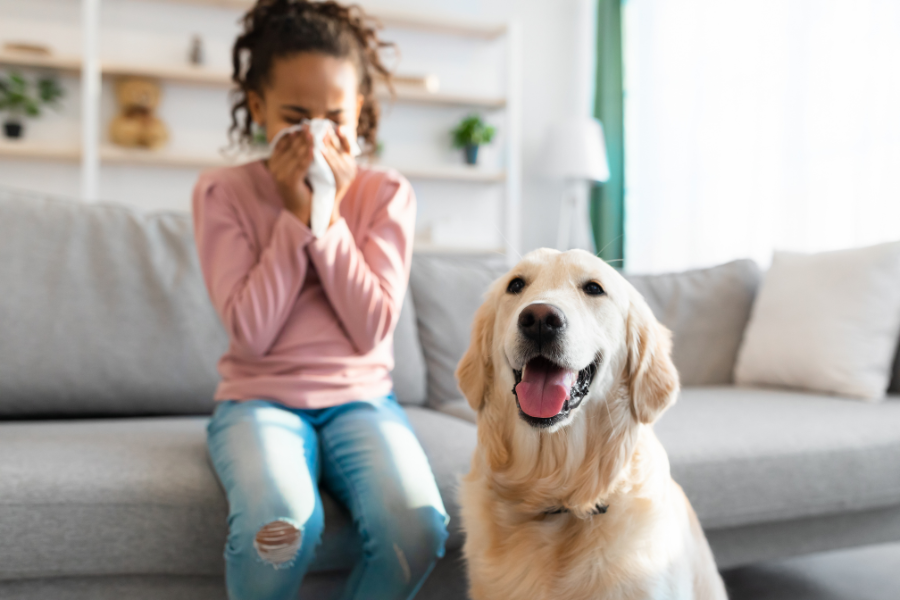Spring has arrived in Texas! As the seasons change, many of us welcome the warmer weather and longer days. However, for those with allergies, asthma, or other respiratory conditions, this time can also bring an unwelcome increase in symptoms due to pollen and other respiratory irritants. Fortunately, there are several steps you can take to minimize the indoor allergens in your home, ensuring a healthier, more comfortable living environment. Here’s a few ways to keep your home clear of pollen and other allergens.

Keep Windows Closed
It might be tempting to open the windows and let in the fresh air, especially after a long winter, but doing so can invite pollen and other airborne allergens into your home. Keep windows closed during high pollen seasons, and rely on air conditioning to keep your home comfortable. Make sure your AC unit has a high-efficiency particulate air (HEPA) filter to trap pollen and other particles effectively. You should be replacing your air filters every couple of months, but consider replacing them every month during these high pollen seasons.
Check Door Gaps
Checking the gaps around doors is a crucial step in maintaining an energy-efficient home and minimizing indoor exposure to pollen. Even small gaps can allow pollen to infiltrate your living spaces, aggravating allergies and respiratory issues. Moreover, these openings can lead to the loss of conditioned air, forcing your heating and cooling systems to work harder and increasing energy bills. To check door gaps, inspect the entire perimeter of your doors for visible light leaks or drafts. Using weather stripping or door sweeps is an effective way to seal these gaps, ensuring a tighter closure that keeps pollen out and conditioned air in. Regular checks and maintenance of these seals can significantly improve indoor air quality and energy efficiency.
Use Air Purifiers
Air purifiers with HEPA filters can significantly reduce the amount of pollen, dust, and other allergens in your indoor air. Place air purifiers in key areas, especially where you spend most of your time, such as bedrooms and living areas. Remember to change the filters regularly according to the manufacturer’s recommendations to ensure the best performance.
Martin Heating & Air has two options for air purification that can be installed directly into your existing home or office HVAC system. Contact our office for details and pricing.
Regular Cleaning
Regular house cleaning can help remove pollen, dust, and other allergens from surfaces in your home. Dust with a damp cloth to avoid spreading allergens into the air, and vacuum at least once a week using a vacuum cleaner with a HEPA filter. Don’t forget to wash bedding, drapes, and other fabrics regularly in hot water to kill dust mites and remove pollen.
Keep Pollen Outside
Take measures to ensure pollen doesn’t hitch a ride into your home. Remove shoes at the door to avoid tracking pollen inside. If you’ve been outdoors during high pollen times, consider changing clothes and taking a shower to rinse pollen from your hair and skin when you come back inside.
Pet Care
Pets can bring in pollen from outside and distribute it throughout your home. Bathe and groom pets regularly to minimize the amount of pollen they carry indoors. Keeping pets off furniture and out of bedrooms can also reduce exposure to pet dander and pollen.
Monitor Pollen Counts
Stay informed about the pollen count in your area using local weather reports or allergy tracking websites. Try to stay indoors on days when the pollen count is particularly high, and plan outdoor activities for times when pollen levels are lower, usually on rainy or less windy days.
Use Dehumidifiers
Mold and dust mites thrive in humid environments, so keeping your home’s humidity levels in check can help reduce these allergens. Use dehumidifiers in damp areas of your home, like bathrooms and kitchens, to maintain a humidity level between 30% and 50%.
Consider Your Landscaping
If you have control over the landscaping around your home, choose plants that are less likely to produce allergenic pollen. Many trees, grasses, and weeds are high pollen producers, so opting for female plants (which don’t produce pollen) or low-pollen varieties can make a big difference in the amount of pollen around your home.
By implementing these strategies, you can significantly reduce the presence of pollen and other respiratory irritants in your home, making for a more comfortable and healthier living environment for everyone, especially those with allergies and respiratory issues. Remember, it’s about taking proactive steps to minimize exposure and protect your indoor air quality.
If you would like more information on how Martin Heating & Air can help you with your indoor air quality please contact us. We are committed to keeping you comfortable indoors all year round.

